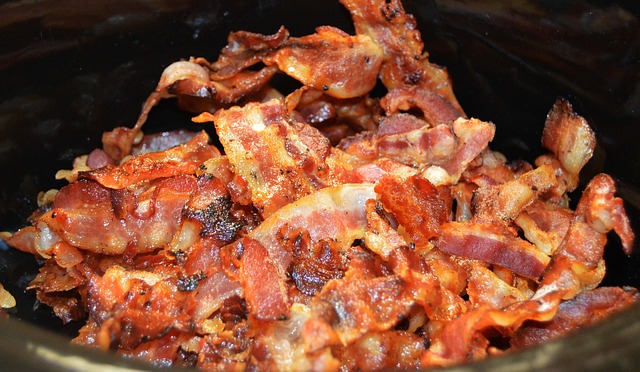Hey there, bacon lovers! You’ve probably heard that bacon is “unhealthy,” but is that really the case? Let’s dig into the nutrition facts, talk about those scary-sounding nitrates and nitrites, and even discuss HCAs. Spoiler alert: in some cases, pork fat might actually be good for you!
The Fat Truth About Bacon
Most of us have been told that bacon should be an occasional treat because the saturated fat will “clog your arteries.” But here’s the thing—the scientific community has pretty much agreed in recent years that saturated fat isn’t the villain we thought it was. It’s actually a natural part of the human diet, just as it has been since humans first appeared.
What scientists are now saying is that highly processed polyunsaturated fats from vegetable oils (like corn and soy) are the real problems, along with too much sugar and starch.
Here’s something interesting—pork fat (lard) is only about 40% saturated fat, with 48% being heart-healthy monounsaturated fat (the same kind in olive oil and avocados!) and 12% polyunsaturated. For comparison, coconut oil is 92% saturated fat, and we all know coconut oil has tons of health benefits!
It’s All About How the Pigs Were Raised
The quality of bacon really depends on how the pigs were raised and what they ate. Factory-raised pigs that never saw daylight and ate nothing but GMO soy and corn will have a less healthy fat profile than free-range pork from animals that grazed outdoors, soaked up sunshine (hello, vitamin D!), and ate a variety of natural foods.
In fact, fat from pasture-raised pigs can be a great source of vitamin D if the animals got plenty of outdoor time. And we all know how crucial vitamin D is for our immune systems and hormonal health.
Unfortunately, most bacon sold today comes from factory farms where pigs get little to no sunshine. Our grandparents were eating 100% pasture-raised bacon back in the day, but modern industrial farming has changed all that.
So if you’re buying bacon, look for pasture-raised or free-range. If you can’t find that, at least go for organic, which means the pigs weren’t fed GMOs.
The Nitrate/Nitrite Debate: Should We Really Worry?
Beyond the fat content, people avoid bacon because they’ve heard nitrites and nitrates are dangerous. But is this really true? Let’s simplify this complicated topic.
First, here’s something that might surprise you: your own body produces more nitrites than you could ever get from food! In fact, 70-90% of our nitrite exposure comes from our own saliva. That’s right—your spit contains more nitrites than anything you could ever eat.
And get this—vegetables contain WAY more naturally-occurring nitrites than processed meats. One serving of arugula has more nitrites than 467 hot dogs! (Sorry if you just spit out your arugula salad in shock.)
That “Nitrite-Free” Label Is Misleading
If you’re paying extra for “nitrite-free” meats, you’re being misled. Instead of sodium nitrite, these products use celery salt for curing, which—guess what—gets transformed into nitrites during the curing process. So your “nitrite-free” bacon probably contains just as many nitrites as regular bacon, if not more!
The Science Says: Nitrites Aren’t That Bad
The fear of nitrites is overblown. There are so many other food ingredients worth worrying about more (like GMOs, trans fats, and high fructose corn syrup).
Scientific research shows that nitrites don’t accumulate in our bodies:
- 25% of nitrates we consume convert to salivary nitrite, 20% convert to nitrite, and the rest leave in our urine within 5 hours
- Absorbed nitrates have a half-life of less than five minutes in our blood
- Some nitrites in our stomach form nitric oxide, which may actually have beneficial effects
What About Nitrosamines?
The real concern with nitrites comes from their potential to form nitrosamines during cooking, which could be carcinogenic. But here’s why that’s not a huge worry:
- Manufacturers add vitamin C (ascorbic acid) when curing meats specifically to prevent nitrosamine formation
- Vitamin E also offers protective effects
- Pasture-raised pork produces fewer nitrosamines when cooked compared to commercial pork
The reason is simple: lard from pasture-raised animals contains a healthier fat profile than fat from grain-fed animals raised in confinement.
The Carcinogen Question
When you fry or bake starchy foods like bread or french fries, carcinogens called acrylamides form. Similarly, when you brown or char meat, heterocyclic amines (HCAs) form on the surface.
But don’t panic! If you’re eating your bacon with antioxidant-rich foods like eggs, veggies, avocado, coffee, or tea (which most of us do), you’re already counteracting those HCAs with powerful antioxidants.
Plus, pork fat contains a unique form of phosphatidylcholine with antioxidant activity superior to Vitamin E. This might explain why lard and bacon fat are relatively stable and resistant to rancidity. Maybe our grandparents were onto something when they cooked with bacon fat instead of inflammatory vegetable oils!
Fun Bacon Fact
Did you know some of the most expensive and healthiest pork in the world comes from Spain, where pigs feast almost exclusively on acorns? These pigs produce meat that’s significantly healthier than corn/soy-fed pigs from factory farms. The best whole-hog barbecue in the southern US traditionally came from acorn-fed pigs too, with a superior taste compared to modern factory farm pork.
It’s a shame that corporate profits have become the pork industry’s priority, rather than the health of the pigs or the nutritional quality of the meat.
So there you have it—bacon might not be the dietary villain you thought it was, especially if you choose the right kind!











